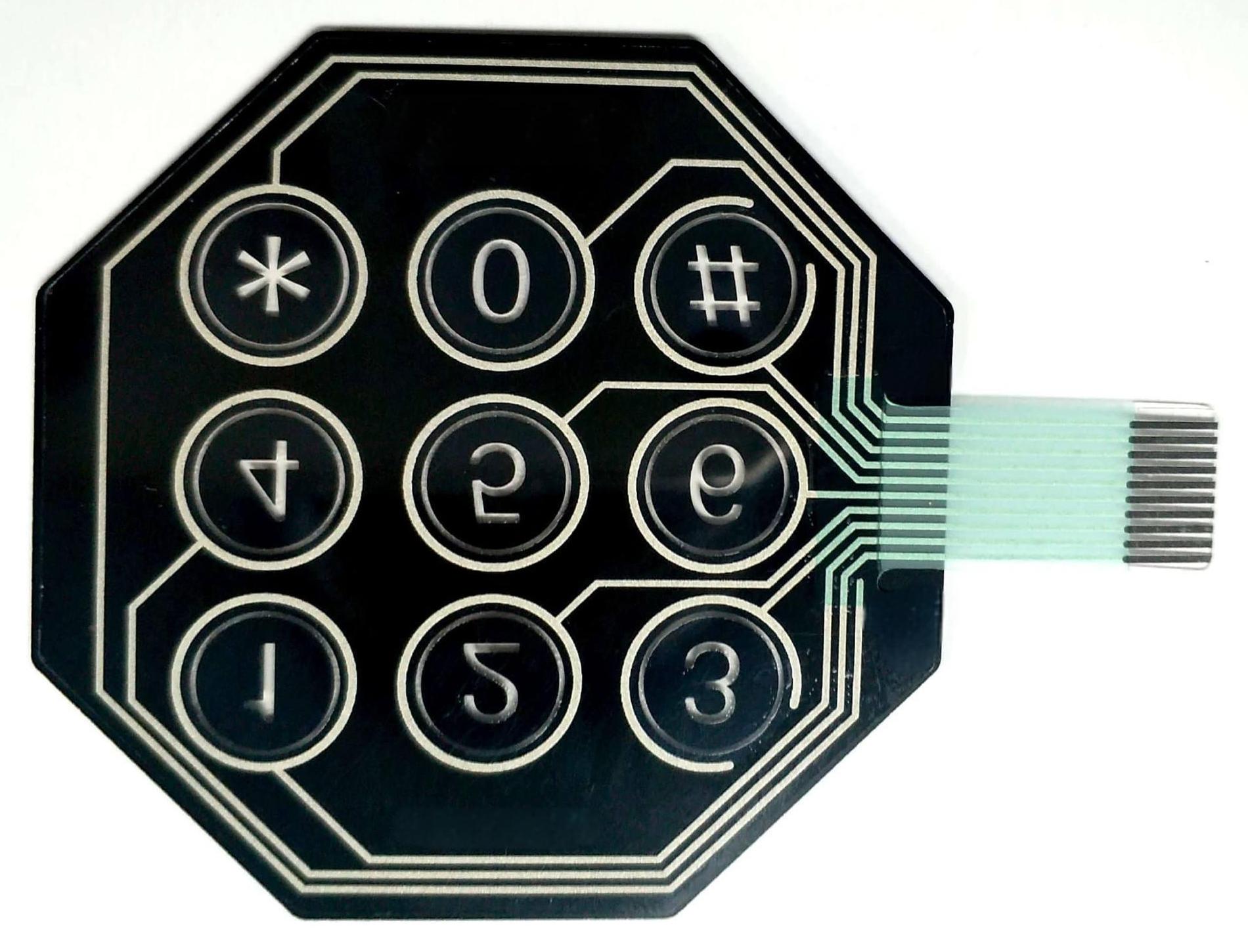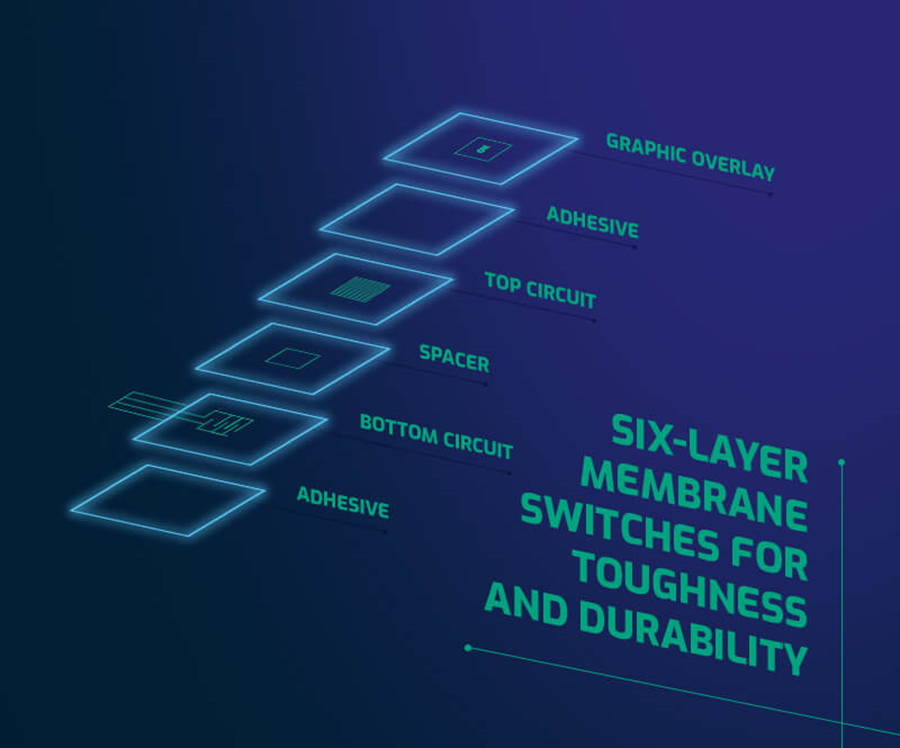Everything About Membrane Switch Over: A Comprehensive Overview for Beginners
Membrane switches are crucial elements in modern-day electronic devices, using an unique interface for user interaction - membrane switch. Their layered construction, consisting of overlays and conductive traces, offers capability and longevity. Unlike standard mechanical buttons, membrane layer switches offer a sleek layout and personalized alternatives. Understanding their vital functions and advantages can change product style. However, the ins and outs of their application and style factors to consider warrant more exploration
What Is a Membrane layer Switch over?
A membrane layer button is a sort of electrical switch that contains a flexible membrane layered over a published circuit card. This style enables a smooth and compact interface, commonly utilized in various digital devices. Membrane buttons are typically found in customer devices, clinical tools, and industrial equipment as a result of their sturdiness and resistance to environmental factors.The construction generally includes several layers, such as visuals overlays and glue backing, which give responsive feedback and safeguard the wiring beneath. The procedure of a membrane layer button is initiated when stress is related to the surface area, finishing an electrical circuit.These switches are valued for their flexibility, making it possible for custom-made styles and published graphics that deal with details user interfaces. Their inconspicuous nature decreases area demands, making them perfect for applications where conventional buttons may not fit. Overall, membrane layer switches offer a aesthetic and functional remedy for modern-day digital tools.
Trick Components of Membrane Switches
Membrane layer switches comprise several vital parts that contribute to their performance and efficiency. The top layer, referred to as the overlay, supplies the user interface and is often published with symbols or graphics. Under the overlay exists a spacer layer, which separates the conductive components and protects against inadvertent activation. The next crucial element is the graphic layer, which boosts aesthetics and ensures the sturdiness of the design.Conductive traces, generally made from products like silver or carbon, are published on the circuit layer. When stress is put on the overlay, these traces enter contact, completing the circuit. In addition, a support layer uses architectural support and can be made from products such as polyester or polycarbonate. Together, these parts create a trusted, straightforward user interface suitable for different applications, from home appliances to commercial equipment. Recognizing these elements is important for anyone thinking about membrane switch technology.
How Membrane Layer Changes Work
Understanding just how membrane changes function is vital for valuing their extensive use in numerous devices. A membrane layer button runs through a series of layers, including a graphic overlay, spacer, and a circuit layer. When pressure is applied to the overlay, it compresses the spacer layer, allowing the circuit layer to make contact and complete an electrical circuit. This action sends out a signal to the gadget, motivating a reaction, such as activating a light or activating a function.Membrane switches over can be made with numerous functions, including responsive feedback, backlighting, and personalized graphics, enhancing individual interaction. Their building and construction permits for a closed layout, securing the internal components from dust, dampness, and pollutants. This sturdiness makes them ideal for varied applications, from customer electronic devices to industrial equipment. On the whole, the simpleness and effectiveness of membrane switches over add to their popularity in contemporary technology.
Benefits of Membrane Layer Switches Over Over Mechanical Buttons
While mechanical buttons have actually long been a staple in several devices, membrane layer switches over offer distinctive benefits that make them significantly appealing. One substantial advantage is their slim profile, permitting for more small designs and better adaptability in item advancement. In addition, membrane layer switches function a consistent surface area, which boosts visual allure and simplifies cleaning, making them ideal for environments where health is critical.Another benefit is their resistance to dust and moisture. Unlike mechanical buttons, which can be jeopardized by environmental elements, membrane switches supply a closed interface that safeguards versus contaminants - membrane switch. Membrane layer buttons commonly have a longer life expectancy due to fewer moving parts, resulting in enhanced resilience and reliability.Cost-effectiveness is also a significant benefit, as membrane layer switches can be created in bulk with reduced manufacturing expenses. These aspects incorporate to position membrane layer switches as a functional option to conventional mechanical choices in different applications
Common Applications of Membrane Switches Over
Membrane buttons are commonly used in various sectors, specifically in customer electronics and industrial control panels. In customer gadgets, they offer a sleek, straightforward user interface, while in industrial setups, they improve sturdiness and functionality. Understanding these applications highlights the convenience and functionality of membrane buttons in contemporary innovation.
Consumer Electronic Devices Tools
As consumer electronic devices continue to advance, membrane buttons have come to be a prominent choice for a selection of gadgets as a result of their adaptability and smooth layout. These switches are generally found in smart devices, tablets, and remotes, where space is minimal and looks matter. Their reduced profile and personalized designs enable suppliers to create easy to use user interfaces that enhance the general user experience. Furthermore, membrane switches are frequently utilized in devices such as microwaves and coffee machine, supplying user-friendly control options while resisting moisture and dirt. The sturdiness and reliability of membrane layer switches over make them suitable for everyday customer products, making sure long life and regular performance. Overall, their combination in customer electronics shows a mix of functionality and modern style.
Industrial Control Panels
The applications of membrane switches extend beyond consumer electronic devices, discovering significant use in commercial control panels. These switches are preferred for their durability and resistance to harsh environments, making them optimal for making and procedure control setups. They provide a trustworthy interface for drivers to manage equipment, display processes, and adjust setups. Membrane buttons can be personalized to fit specific functional needs, incorporating features like backlighting and tactile feedback, enhancing individual experience. Their inconspicuous style permits integration right into different equipment, while their capacity to hold up against spills, dirt, and severe temperature levels warranties longevity. In this article general, membrane layer switches add to risk-free and efficient procedure in commercial applications, demonstrating their convenience and performance in requiring settings.
Factors To Consider for Designing Membrane Layer Changes
When designing membrane layer buttons, selecting the best products is vital to ensure durability and performance. Furthermore, comprehending layer setup techniques can significantly influence the button's efficiency and individual experience. These considerations play an essential function in developing reputable and reliable membrane layer switch designs.
Product Choice Importance
Product choice plays dig this a crucial role in the layout and capability of membrane switches. The selected products directly affect the switch's longevity, tactile response, and total aesthetic. Trick considerations include the substrate, which should give architectural honesty while permitting for flexibility, and the visuals overlay, which needs to be resistant to use and ecological variables. Conductive products must guarantee dependable electric performance, while adhesives must use solid bonding without endangering the button's procedure. In addition, compatibility with manufacturing processes and end-user atmospheres is essential; materials should hold up against varying temperatures, humidity degrees, and chemical direct exposure. Eventually, proper product option not just enhances the membrane switch's performance but also adds to its long life and individual complete satisfaction, making it an essential aspect of the layout procedure.

Layer Setup Strategies

Often Asked Questions
For How Long Do Membrane Layer Changes Commonly Last?
Membrane buttons typically have a lifespan of 1 to 5 million cycles, relying on use and ecological problems. Variables such as layout high quality and operating frequency considerably influence their resilience and total efficiency durability.

Can Membrane Layer Switches Be Customized for Certain Layouts?
Membrane layer switches can undoubtedly be customized to suit details layouts, enabling diverse forms, colors, and capabilities. This convenience makes it possible for makers to customize these buttons to fulfill special visual and operational demands efficiently.
What Products Are Used in Membrane Layer Change Building?
Membrane layer switches are usually built using materials such as polyester, polycarbonate, and sticky layers. These products offer toughness, resistance, and versatility to ecological variables, guaranteeing the buttons function successfully in different applications and problems.
Are Membrane Layer Changes Water-proof or Immune to Wetness?
Membrane switches can be created to be moisture-resistant, making use of specialized materials and coverings. Nevertheless, their water-proof capabilities depend upon building and construction quality and certain applications, making it important to examine demands for ideal efficiency in various atmospheres.
How Are Membrane Layer Changes Fixed if Damaged?
Repairing damaged membrane layer changes usually entails replacing the impacted layer or circuit. Specialists may likewise use conductive glue or make use of specialized repair packages, making sure performance is restored without complete substitute of the entire button setting up. Unlike standard mechanical buttons, membrane layer buttons provide a sleek style and customizable alternatives. A membrane layer switch is a kind of electrical button that consists of an adaptable membrane layer layered over a printed circuit board. The procedure of a membrane layer button is started when stress is applied to the surface area, completing an electric circuit.These switches are valued for their convenience, allowing custom designs and published graphics that cater to certain user interfaces. While mechanical switches have long been a staple in many gadgets, membrane layer switches over offer distinct benefits that make them progressively appealing. Membrane buttons commonly have a longer life expectancy due to fewer moving parts, resulting in improved longevity and reliability.Cost-effectiveness is additionally a notable advantage, as membrane buttons can be generated in mass with lower manufacturing expenses.